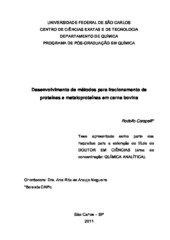Desenvolvimento de métodos para fracionamento de proteínas e metaloproteínas em carne bovina
Abstract
This thesis aimed the fractionation of metalloproteins in beef samples. To this purpose initially it was proposed a method for extraction of proteins using the sample extractor in buffered alkaline medium and surfactant solutions. After optimization were observed approximately 85% extraction efficiency and r.s.d. < 5%, showing the efficiency, reproducibility, simplicity and velocity of the method. After that, the experimental conditions for the fractionation of metalloproteins were evaluated. High performance liquid chromatography (HPLC) and polyacrylamide gel electrophoresis (PAGE) were used for physical-chemical separation and mass spectrometry and optical emission inductively coupled argon plasma (ICP OES and ICP-MS, respectively) as detection methods. The analytes Ca, Cu, Fe, Mg and Zn were evaluated; however, Mg was not detected in any condition of the study. To obtain a condition of appointment of detection for the other four elements, it was chosen to use less energy plasma conditions in ICP-MS (cool plasma), in order to avoid isobaric interference emanating from the plasma when the determination of the elements Ca and Fe. Finally, samples of meat with different maturation stages were analyzed by PAGE and HPLC-ICP-MS. Approximately 17 protein bands could be observed by PAGE and the band of 43 kDa was the more intense. Some peaks were detected for each element by HPLC size exclusion. All items showed at least a fraction above the dead volume of the column, Fe and Zn, and this fraction, also showed a fraction of 17 and 27 kDa respectively.
